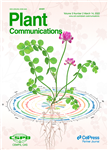An atypical NLR gene confers bacterial wilt susceptibility in Arabidopsis
作者机构:LIPMEUniversite de ToulouseINRAECNRSCastanet-TolosanFrance Shanghai Center for Plant Stress BiologyCAS Center for Excellence in Molecular Plant SciencesChinese Academy of SciencesShanghaiChina Universite Paris-SaclayINRAEAgroParisTechInstitut Jean-Pierre Bourgin(IJPB)78000 VersaillesFrance Present address:Department of Cell&Systems BiologyUniversity of TorontoTorontoONCanada Present address:Department of BiologyNYU12 Waverly PlaceNew YorkNY 10003USA
出 版 物:《Plant Communications》 (植物通讯(英文))
年 卷 期:2023年第4卷第5期
页 面:277-294页
核心收录:
学科分类:0710[理学-生物学] 07[理学] 071007[理学-遗传学]
基 金:supported by the Laboratoire d’Excellence(LABEX)TULIP(ANR-10-LABX-41) funded by a grant from the Lebanese University INRAE,Campus France,and the INRAE Plant Health and Environment division(SPE)for their support and funding a PhD grant co-financed by the Occitanie Regional Council and the INRAE Plant Health and Environment division(SPE) funded by a grant from the French Ministry of National Education and Research supported by France Genomique National infrastructure funded as part of the Investissement d’avenir program managed by Agence Nationale de la Recherche(contract ANR-10-INBS-09).
主 题:Ralstonia solanacearum typeⅢeffectors Arabidopsis thaliana GWAS R gene susceptibility
摘 要:Quantitative disease resistance(QDR)remains the most prevalent form of plant resistance in crop fields and wild habitats.Genome-wide association studies(GWAS)have proved to be successful in deciphering the quantitative genetic basis of complex traits such as QDR.To unravel the genetics of QDR to the devastating worldwide bacterial pathogen Ralstonia solanacearum,we performed a GWAS by challenging a highly polymorphic local mapping population of Arabidopsis thaliana with four R.solanacearum type III effector(T3E)mutants,identified as key pathogenicity determinants after a first screen on an A.thaliana core collection of 25 accessions.Although most quantitative trait loci(QTLs)were highly specific to the identity of the T3E mutant(ripAC,ripAG,ripAQ,and ripU),we finely mapped a common QTL located on a cluster of nucleotide-binding domain and leucine-rich repeat(NLR)genes that exhibited structural variation.We functionally validated one of these NLRs as a susceptibility factor in response to R.solanacearum,named it Bacterial Wilt Susceptibility 1(BWS1),and cloned two alleles that conferred contrasting levels of QDR.Further characterization indicated that expression of BWS1 leads to suppression of immunity triggered by different R.solanacearum effectors.In addition,we showed a direct interaction between BWS1 and RipAC T3E,and BWS1 and SUPPRESSOR OF G2 ALLELE OF skp1(SGT1b),the latter interaction being suppressed by RipAC.Together,our results highlight a putative role for BWS1 as a quantitative susceptibility factor directly targeted by the T3E RipAC,mediating negative regulation of the SGT1-dependent immune response.



